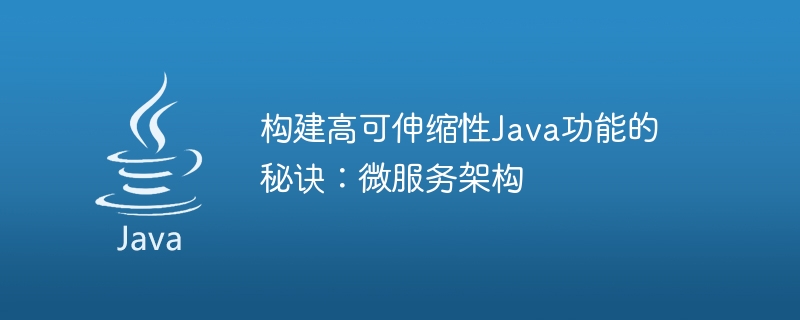Home >Java >javaTutorial >Secrets to Building Highly Scalable Java Functions: Microservice Architecture
Secrets to Building Highly Scalable Java Functions: Microservice Architecture
- PHPzOriginal
- 2023-09-18 16:30:51744browse

The Secret to Building Highly Scalable Java Functions: Microservice Architecture
Introduction
Modern software development pays more and more attention to high scalability. That is, it can maintain good performance in the face of growing users and traffic. The microservice architecture is an architectural pattern that is widely adopted to achieve this goal. This article will introduce the concept of microservice architecture in detail and give some specific Java code examples to help readers better understand how to build highly scalable Java functions.
- What is microservice architecture?
Microservices architecture is an architectural pattern that splits an application into a set of small and autonomous services. Each service has an independent code base and database, and can be deployed, scaled and maintained independently. The advantage of this split is that the responsibilities of each service are clearer, and teams can focus more on their own areas and use the technology stack that suits them. In addition, microservices architecture provides greater scalability and fault tolerance because each service is able to handle requests, scaling, and failures independently.
- Building microservices using Spring Cloud
Spring Cloud is an open source framework for building distributed systems. It provides a series of components to help developers build and manage microservices more easily. The following is a simple example showing how to use Spring Cloud to build a simple microservice architecture:
First, add Spring Cloud dependencies in the pom.xml file of each microservice:
<dependencies>
<dependency>
<groupId>org.springframework.cloud</groupId>
<artifactId>spring-cloud-starter-netflix-eureka-server</artifactId>
</dependency>
<dependency>
<groupId>org.springframework.cloud</groupId>
<artifactId>spring-cloud-starter-netflix-eureka-client</artifactId>
</dependency>
<!-- 其他依赖... -->
</dependencies>Next, we can create an Eureka server to register and manage the microservice:
@SpringBootApplication
@EnableEurekaServer
public class EurekaServer {
public static void main(String[] args) {
SpringApplication.run(EurekaServer.class, args);
}
}Then, we can create a microservice and register it to the Eureka server:
@SpringBootApplication
@EnableDiscoveryClient
public class UserService {
public static void main(String[] args) {
SpringApplication.run(UserService.class, args);
}
}Finally, we can Create another microservice to consume the interface provided by UserService:
@SpringBootApplication
@EnableFeignClients
public class OrderService {
public static void main(String[] args) {
SpringApplication.run(OrderService.class, args);
}
}- Use load balancing to achieve high scalability
When building high scalability Java functions, load Balance is an important aspect. By placing a load balancer in front of your microservices, you can achieve a balanced distribution of requests and avoid overloading or crashing a single service.
The following is a specific code example for using Ribbon and Eureka to achieve load balancing:
First, we need to add Ribbon and Eureka dependencies in the pom.xml file of each microservice:
<dependencies>
<dependency>
<groupId>org.springframework.cloud</groupId>
<artifactId>spring-cloud-starter-netflix-ribbon</artifactId>
</dependency>
<dependency>
<groupId>org.springframework.cloud</groupId>
<artifactId>spring-cloud-starter-netflix-eureka-client</artifactId>
</dependency>
<!-- 其他依赖... -->
</dependencies>Next, we can use the @LoadBalanced annotation to create a RestTemplate with load balancing function, and implement remote invocation of the service through Ribbon:
@Configuration
public class RibbonConfig {
@Bean
@LoadBalanced
public RestTemplate restTemplate(){
return new RestTemplate();
}
}Then, we can use this RestTemplate to implement the Remote call of UserService:
@RestController
public class OrderController {
@Autowired
private RestTemplate restTemplate;
@GetMapping("/users")
public List<User> getUsers(){
return restTemplate.getForObject("http://user-service/users",List.class);
}
}- Use message queue to implement asynchronous communication
When faced with high traffic, synchronous request and response patterns may cause service delays and performance question. To solve this problem, we can use message queues as an asynchronous communication mechanism between microservices. Message queues can decouple requests and responses and improve overall system performance.
The following is a specific code example for using Kafka to implement asynchronous communication:
First, we need to add Kafka dependencies in the pom.xml file of each microservice:
<dependencies>
<dependency>
<groupId>org.springframework.kafka</groupId>
<artifactId>spring-kafka</artifactId>
</dependency>
<!-- 其他依赖... -->
</dependencies>Next, we can create a Kafka message producer to send messages to the specified topic:
@Service
public class KafkaProducer {
@Autowired
private KafkaTemplate<String, String> kafkaTemplate;
public void sendMessage(String message){
kafkaTemplate.send("my-topic", message);
}
}Then, we can create a Kafka message consumer to receive messages from the specific topic and process them:
@Service
public class KafkaConsumer {
@KafkaListener(topics = "my-topic")
public void receiveMessage(String message){
// 处理接收到的消息
}
}Summary
By adopting microservice architecture and using technical means such as load balancing and message queues, we can build highly scalable Java functions. Microservices architecture breaks applications into small, autonomous services that can better adapt to growing users and traffic. Load balancing and message queues can further improve system performance and fault tolerance. Hopefully the code examples in this article will help readers better understand how to implement these features and be successful in practice.
The above is the detailed content of Secrets to Building Highly Scalable Java Functions: Microservice Architecture. For more information, please follow other related articles on the PHP Chinese website!

